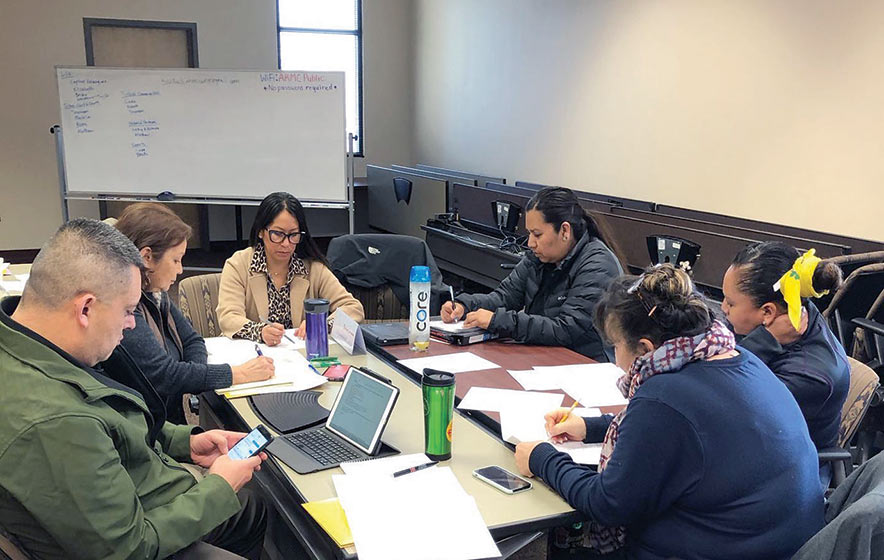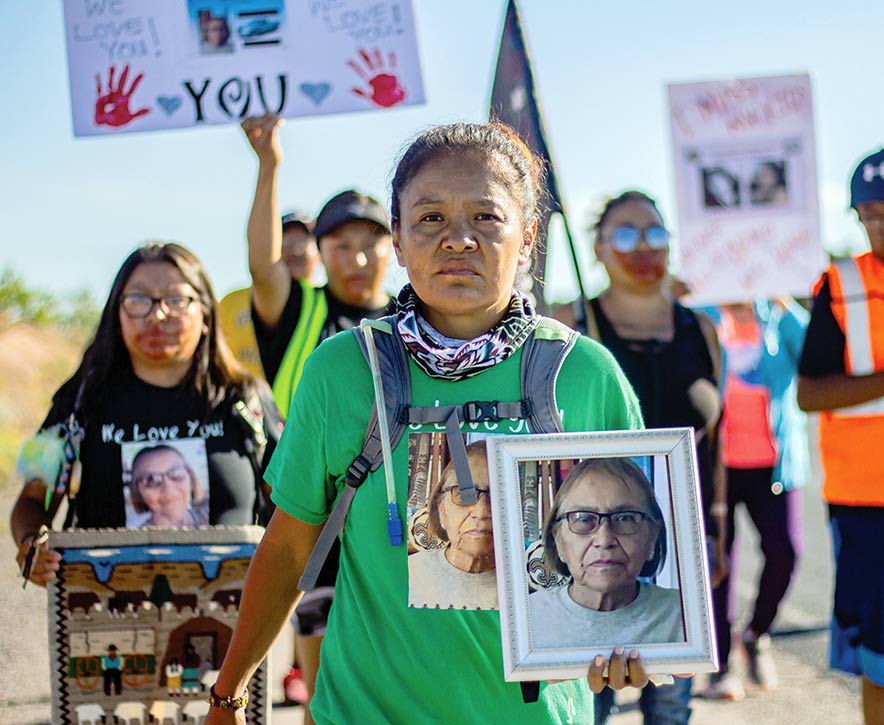
Cycle breaker: State, tribes, families take on multi-faceted plan to end violence

Courtesy photo | NM Indian Affairs Dept.
With Cabinet Secretary Lynn Trujillo sitting at the head of the table, MMIWR Task Force members work face-to-face before the COVID-19 pandemic forced meetings online or through telecommunications.
By Colleen Keane
Special to the Times
ALBUQUERQUE
For the last two years, a Native-led task force has been working nonstop through the pandemic to uncover the many layers of suspects, jurisdictions, gaps in service and laws that have resulted in New Mexico leading the nation with the highest number of missing and murdered Native women and their relatives in the country.
The Missing and Murdered Indigenous Women and Relatives Task Force was created by the Legislature in 2019.
It was signed into law by New Mexico Gov. Michelle Lujan Grisham on March 28, 2019.
In May, Lujan Grisham released the task force’s findings in the report “New Mexico’s MMIWR Response Plan,” most likely the first of its kind, according to Lynn Trujillo, Sandia Pueblo, cabinet secretary for Indian affairs.
“This (plan) is guided by the wisdom and voices of family members of women and relatives that have gone missing or been murdered,” Trujillo said in an email to the Navajo Times, “people who have been trafficked, victim’s advocates, spiritual leaders and healers, community educators, mental and behavioral health providers, law enforcement, legal advocates, policy makers, policy analysts and staff from tribal, state, and local government,” she said.
The task force reports that Native women and relatives experience more violence than any other segment of the American population.
Referring to National Crime Information Center data, more than 5,700 American Indian and Alaska Native women and girls were reported missing as of 2016.
They also found that in some tribal communities, the murder rate is 10 times higher than non-Native communities.
In Albuquerque alone, there were 287 missing Native women over a five-year period. In Farmington, two thirds of the people reported missing in recent years are Native women.
Researchers say data is so unavailable, no one knows how many murdered or abducted women there really are.
Ella Mae Begay

Navajo Times File | Cyrus Norcross
Frustrated with the Navajo Nation Police and the Navajo Nation government, Seraphine Warren (green shirt) starts marching from Sweetwater, Ariz.. to Window Rock on July 20, 2021, to raise awareness about her aunt, Ella Mae Begay, as well as Missing and Murdered Indigenous Women and Girls. Warren has questions that she wants answered from the Navajo Nation leaders.
One of the missing is the well-known Navajo weaver Ella Mae Begay, who disappeared from her home in Sweetwater, Arizona, a year ago.
Seraphine Warren, her niece, began a 2,500-mile prayer walk from Sweetwater to Washington, D.C., on June 15 to raise awareness about her aunt and other missing and murdered indigenous women and relatives.
A media advisory notes that law enforcement agencies have not divulged any meaningful updates regarding their investigation, something that happens in most cases leaving families to investigate themselves.
“Grieving families are wholly responsible for keeping the attention of authorities and the public regarding their missing loved ones,” the advisory notes.
Trujillo, who is also the board chair for the task force, hopes that justice will prevail.
“Collectively, we can address the complex issues that contribute to the high rates of violence against Indigenous peoples and all New Mexicans,” she said.
Warren’s walk can be followed on Facebook at Tracing Ella Mae. There is also a Go Fund Me account.
Regarding Ella Mae and other missing women and relatives, the task force found that among the reasons for high murders and disappearances is insufficient police protection on the Navajo Nation. Current Bureau of Indian Affairs funding meets 42% of law enforcement needs.
The task force also documents the legacy of colonialism, racism and sexism play significant contributing roles.
The task force explains why in cases of trafficking, indigenous women and relatives are targeted.
Jessica Smith, an MMIWR advocate, said when it comes to trafficking, “Certain populations are especially vulnerable. These may include undocumented migrants, runaway and homeless youth, and oppressed, marginalized, and/or impoverished groups and individuals. Native people are at exceptionally high risk for trafficking.”
Tribal leaders
To provide a platform for tribal leadership, the Coalition to Stop Violence Against Native Women began hosting annual tribal leader summits on violence against women around 2014.
“This is the eighth year bringing together tribal leaders, advocates and community in a tribal summit,” Angel Charley, Laguna, coalition executive director, told people attending the virtual event held on March 30 and 31. “We believe safety is a community effort and it will take all of us to create the future we want for ourselves.”
Navajo Nation Council delegates Vince James and Amber Kanazbah Crotty and leaders from the Zuni, Ohkay Owingeh, Santa Ana, Acoma, Tesuque, Isleta, and Nambe pueblos, to name some, participated in the 2022 summit.
During the Tribal Leader Summit, Charley said it was a pivotal time and social/political environment for change to take place, referring to the reauthorization of the Violence Against Women Act, Deb Haaland’s appointment as Secretary of Interior, and codification of the state’s Indian Child Welfare Act, now called the Indian Families Protection Act.
Also the passage of bills like Senate Bill 13 which orders the state Public Safety Department to annually host a “missing in New Mexico” event to support families and victims by sharing information, opening up lines of communication and outreaching to the media, to name some of the provisions.
“Today we have so much to celebrate and be grateful for,” Charley said. “It is the work of our tribal leaders, advocates and families that have brought us here. Now is the time to seize this moment we have before us. It is a moment when we can seize the opportunity and shape our future.”
Trujillo said the work has already started.
“In 2021, we forged partnerships with the Department of Public Safety, the attorney general’s office, and county level district attorney offices to find solutions to this crisis all with the support of Governor Lujan Grisham.”
She added that the city of Albuquerque and Albuquerque Police Department are using the response plan to improve communication by establishing MMIWR liaisons so there is a direct point of contact in the event of an emergency.
Albuquerque Mayor Tim Keller said, “No community should have to answer this call to action alone. Albuquerque supports the work ahead in the state response plan. Families deserve answers and justice.”
Trailing Ella Mae
Meanwhile, Warren, Ella Mae’s niece, is continuing her proactive steps.
According to a Facebook post, she reached the Enchanted Trails RV Park west of Albuquerque on Sunday and then planned to set out for the city on Tuesday.
“We encourage all task force members, relatives and everyone to support Ms. Warren with prayers and financial support,” Trujillo said.
Information: iad.state.nm.us, Trailing Ella Mae on Facebook and Go Fund Me, navajonationcouncil.org, cabq.gov, nmlegis.gov, csvanw.org








 Highway 264,
Highway 264, I-40, WB @ Winslow
I-40, WB @ Winslow